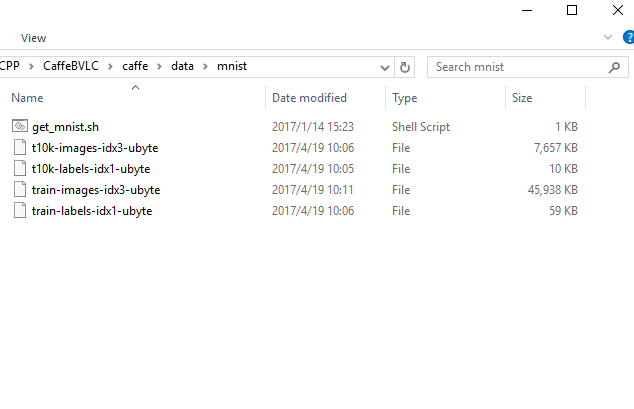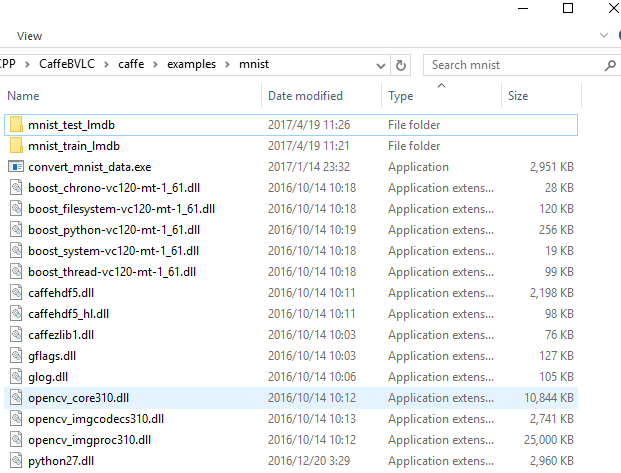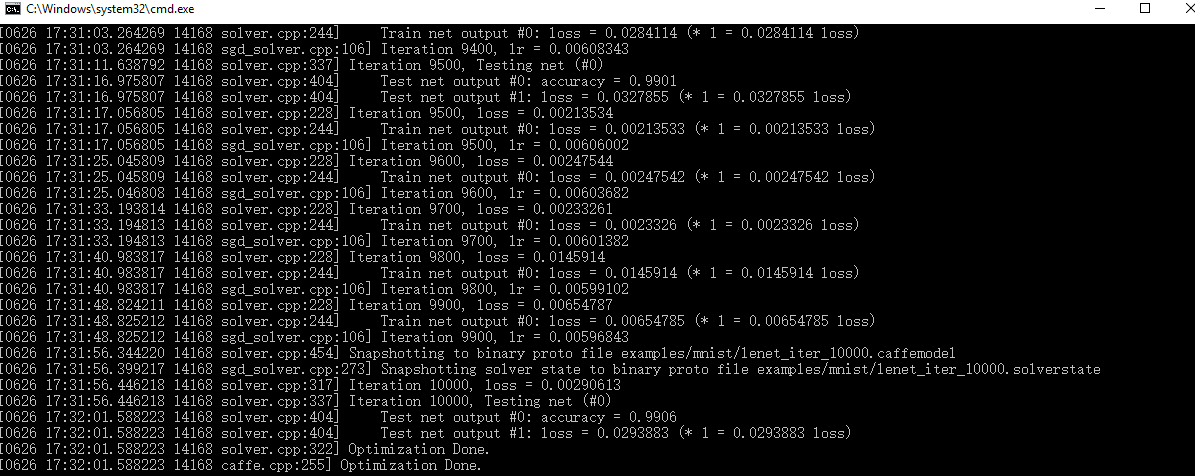安装好caffe之后,可以尝试下caffe自带的例子mnist。官方教程如下:
http://caffe.berkeleyvision.org/gathered/examples/mnist.html
首先运行如下命令,下载MNIST数据
cd $CAFFE_ROOT
./data/mnist/get_mnist.sh
./examples/mnist/create_mnist.sh其中$CAFFE_ROOT代表安装caffe的目录。但是很可能无法下载,因为要求安装wget和gunzip,而windows下wget和gunzip需要另行安装。因此可查看get_mnist.sh文件,手动下载如下四个文件
http://yann.lecun.com/exdb/mnist/train-images-idx3-ubyte.gz
http://yann.lecun.com/exdb/mnist/train-labels-idx1-ubyte.gz
http://yann.lecun.com/exdb/mnist/t10k-images-idx3-ubyte.gz
http://yann.lecun.com/exdb/mnist/t10k-labels-idx1-ubyte.gz
下载之后解压到$CAFFE_ROOT/data/mnist/文件夹下。如下图所示

此处CaffeBVLC\caffe目录即为$CAFFE_ROOT。
接下来将$CAFFE_ROOT\build\examples\mnist\Release\convert_mnist_data.exe复制到$CAFFE_ROOT\examples\mnist\目录下,并执行如下指令
cd $CAFFE_ROOT\examples\mnist
convert_mnist_data.exe ..\..\data\mnist\train-images-idx3-ubyte \
..\..\data\mnist\train-labels-idx1-ubyte mnist_train_lmdb --backend=lmdb
convert_mnist_data.exe ..\..\data\mnist\t10k-images-idx3-ubyte \
..\..\data\mnist\t10k-labels-idx1-ubyte mnist_test_lmdb --backend=lmdb注意执行过程中可能遇到缺少dll的报错,把所有缺少的dll都从$CAFFE_ROOT目录中找到,然后复制到$CAFFE_ROOT\examples\mnist目录中即可,如下图所示(python27.dll需从python安装目录处获得;或者在Anaconda的python2.7终端中运行,则无需复制python27.dll。以下命令皆为在Anaconda环境中执行)

执行上述指令后,该目录下多了两个目录,mnist_test_lmdb和mnist_train_lmdb,如上图所示。
将之前可以成功运行的caffe.exe所在目录添加到PATH环境变量中,该目录为$CAFFE_ROOT\build\tools\Release,然后在$CAFFE_ROOT目录下运行如下命令(此处可参考上一篇文章 《Windows下安装TensorFlow和Caffe》)
cd $CAFFE_ROOT
caffe.exe train --solver=examples\mnist\lenet_solver.prototxt运行结果如下

上图的输出表明,caffe成功运行,对mnist数据集进行了训练和测试。训练模型保存在$CAFFE_ROOT\examples\mnist\lenet_iter_10000.caffemodel文件中,可部署在应用中进行识别。
下面简单介绍一下caffe中的模型定义和配置文件。首先看看lenet_solver.prototxt,其内容如下
# The train/test net protocol buffer definition
net: "examples/mnist/lenet_train_test.prototxt"
# test_iter specifies how many forward passes the test should carry out.
# In the case of MNIST, we have test batch size 100 and 100 test iterations,
# covering the full 10,000 testing images.
test_iter: 100
# Carry out testing every 500 training iterations.
test_interval: 500
# The base learning rate, momentum and the weight decay of the network.
base_lr: 0.01
momentum: 0.9
weight_decay: 0.0005
# The learning rate policy
lr_policy: "inv"
gamma: 0.0001
power: 0.75
# Display every 100 iterations
display: 100
# The maximum number of iterations
max_iter: 10000
# snapshot intermediate results
snapshot: 5000
snapshot_prefix: "examples/mnist/lenet"
# solver mode: CPU or GPU
solver_mode: CPU
第一行定义了模型文件的位置,后面两行定义了测试迭代次数,迭代100次,每500次训练进行一次网络测试。base_lr,momentum和weight_decay定义了网络学习速率,动量和权重衰减速率。lr_policy,gamma和power定义了优化算法及参数,display定义了每100次迭代显示一次结果,max_iter定义了最大迭代次数。snapshot和snapshot_prefix定义了每隔多少次训练保存一次网络参数,以及网络参数保存的文件前缀(包括目录)。solver_mode定义了CPU计算还是GPU计算。
然后看看lenet_train_test.prototxt
name: "LeNet"
layer {
name: "mnist"
type: "Data"
top: "data"
top: "label"
include {
phase: TRAIN
}
transform_param {
scale: 0.00390625
}
data_param {
source: "examples/mnist/mnist_train_lmdb"
batch_size: 64
backend: LMDB
}
}
layer {
name: "mnist"
type: "Data"
top: "data"
top: "label"
include {
phase: TEST
}
transform_param {
scale: 0.00390625
}
data_param {
source: "examples/mnist/mnist_test_lmdb"
batch_size: 100
backend: LMDB
}
}
layer {
name: "conv1"
type: "Convolution"
bottom: "data"
top: "conv1"
param {
lr_mult: 1
}
param {
lr_mult: 2
}
convolution_param {
num_output: 20
kernel_size: 5
stride: 1
weight_filler {
type: "xavier"
}
bias_filler {
type: "constant"
}
}
}
layer {
name: "pool1"
type: "Pooling"
bottom: "conv1"
top: "pool1"
pooling_param {
pool: MAX
kernel_size: 2
stride: 2
}
}
layer {
name: "conv2"
type: "Convolution"
bottom: "pool1"
top: "conv2"
param {
lr_mult: 1
}
param {
lr_mult: 2
}
convolution_param {
num_output: 50
kernel_size: 5
stride: 1
weight_filler {
type: "xavier"
}
bias_filler {
type: "constant"
}
}
}
layer {
name: "pool2"
type: "Pooling"
bottom: "conv2"
top: "pool2"
pooling_param {
pool: MAX
kernel_size: 2
stride: 2
}
}
layer {
name: "ip1"
type: "InnerProduct"
bottom: "pool2"
top: "ip1"
param {
lr_mult: 1
}
param {
lr_mult: 2
}
inner_product_param {
num_output: 500
weight_filler {
type: "xavier"
}
bias_filler {
type: "constant"
}
}
}
layer {
name: "relu1"
type: "ReLU"
bottom: "ip1"
top: "ip1"
}
layer {
name: "ip2"
type: "InnerProduct"
bottom: "ip1"
top: "ip2"
param {
lr_mult: 1
}
param {
lr_mult: 2
}
inner_product_param {
num_output: 10
weight_filler {
type: "xavier"
}
bias_filler {
type: "constant"
}
}
}
layer {
name: "accuracy"
type: "Accuracy"
bottom: "ip2"
bottom: "label"
top: "accuracy"
include {
phase: TEST
}
}
layer {
name: "loss"
type: "SoftmaxWithLoss"
bottom: "ip2"
bottom: "label"
top: "loss"
}
首先是定义网络名称
name: "LeNet"
然后是把数据读入网络的数据层,其中一个数据层仅用于训练(train),另一个仅用于测试(test)
layer {
name: "mnist"
type: "Data"
top: "data"
top: "label"
include {
phase: TRAIN
}
transform_param {
scale: 0.00390625
}
data_param {
source: "examples/mnist/mnist_train_lmdb"
batch_size: 64
backend: LMDB
}
}
layer {
name: "mnist"
type: "Data"
top: "data"
top: "label"
include {
phase: TEST
}
transform_param {
scale: 0.00390625
}
data_param {
source: "examples/mnist/mnist_test_lmdb"
batch_size: 100
backend: LMDB
}
}该层名称为mnist,类型为数据层,从给定的lmdb数据源中读取数据。batch_size定义了一次读入的数据量,0.00390625表示1/256,给出像素标度,使其值为[0,1)之间。该层给出两个输出单元(top),一个是数据单元,一个是标签单元。
然后是卷积层
layer {
name: "conv1"
type: "Convolution"
bottom: "data"
top: "conv1"
param {
lr_mult: 1
}
param {
lr_mult: 2
}
convolution_param {
num_output: 20
kernel_size: 5
stride: 1
weight_filler {
type: "xavier"
}
bias_filler {
type: "constant"
}
}
}该层以上一层输出的数据单元作为输入,产生20个输出通道,其卷积核大小为5,stride为1。fillers通过随机方式初始化权重和偏差,对于权重fillers,采用xavier算法以自动根据输入输出神经元数量决定初值大小。对于bias fillers,简单将其置为常数0。lr_mults是可动态调整的学习速率,此处设置权重学习速率为solver中设置的值,而常数学习速率则为solver中的两倍,这样通常会带来更好的收敛性。
然后是Pooling层
layer {
name: "pool1"
type: "Pooling"
bottom: "conv1"
top: "pool1"
pooling_param {
pool: MAX
kernel_size: 2
stride: 2
}
}此处采用最大pooling,pool核为2,stride为2。类似地,在lenet_train_test.prototxt中可看到第二个卷积层和pooling层。
然后是全连接层
layer {
name: "ip1"
type: "InnerProduct"
bottom: "pool2"
top: "ip1"
param {
lr_mult: 1
}
param {
lr_mult: 2
}
inner_product_param {
num_output: 500
weight_filler {
type: "xavier"
}
bias_filler {
type: "constant"
}
}
}此处定义了一个500个输出的全连接层。
然后是ReLU层
layer {
name: "relu1"
type: "ReLU"
bottom: "ip1"
top: "ip1"
}由于ReLU是元素级操作,可以直接修改元素以节约内存,这一点通过定义相同名称的top和bottom来实现。在ReLU层之后,可以定义另一个全连接层,见lenet_train_test.prototxt。
最后是loss层,
layer {
name: "loss"
type: "SoftmaxWithLoss"
bottom: "ip2"
bottom: "label"
}softmax_loss层实现了softmax和多维对数loss。其有两个输入,第一个是计算结果,第二个是数据层的标签。该层并不产生任何输出,仅计算loss函数的值,然后通过反向传播算法初始化梯度。
注意lenet_train_test.prototxt中还有一个accuracy层,该层的作用和loss层相同,唯一的区别是accuracy仅在测试中用于计算精度。






















 4万+
4万+

 被折叠的 条评论
为什么被折叠?
被折叠的 条评论
为什么被折叠?








